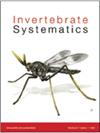秘鲁透明藻属一新种记述及透明藻科分子系统发育(甲壳纲,片足纲)
IF 1.9
2区 生物学
Q3 EVOLUTIONARY BIOLOGY
引用次数: 0
摘要
摘要近年来,与全球变暖相关的水温上升对冷水淡水生物的影响已成为一个主要问题,了解支持温度限制的生理和生态因素对淡水生物的保护生物学至关重要。我们描述了一种来自秘鲁印加卡哈马卡(Baños del Inca Cajamarca)温泉的嗜热透明类片足动物Hyalella yashmara sp. nov.,这可能有助于理解这些动物的高温偏好。我们发现这个新物种可以生活在19.8到52.1°C的水温范围内,据我们所知,这是有记录的片脚类动物栖息地的最高温度。Hyalella yashmara sp. 11 .与1899年秘鲁的H. meinerti Stebbing最相似。然而,这个新种与后者在颚足类1和2、胸骨鳃、尾足类3和触须的特征上有所不同。本文还提供了亚什马拉透明菌与秘鲁品种的详细形态比较。我们基于核28S rRNA和线粒体细胞色素c氧化酶亚基I (COI)基因序列的分子系统发育分析有力地支持了透明菌科(=Hyalella)的单系性。由于Hyalellidae被发现与Chiltoniidae形成姐妹群,这两个家族被认为起源于一个共同的祖先,当南美洲、非洲和澳大利亚大陆合并为冈瓦纳大陆时,他们从海洋环境中入侵淡水栖息地。我们的研究结果表明,南美的玻氏菌不是单系的,北美的玻氏菌很可能与H. yashmara sp. 11 .有共同的祖先本文章由计算机程序翻译,如有差异,请以英文原文为准。
Description of a new thermal species of the genus Hyalella from Peru with molecular phylogeny of the family Hyalellidae (Crustacea, Amphipoda)
Abstract. In recent years, the impact of rising water temperatures associated with global warming on cold-water freshwater organisms has become a major issue, and understanding the physiological and ecological elements that support temperature limits is essential for the conservation biology of freshwater organisms. We describe a new species of thermophilic hyalellid amphipod, Hyalella yashmara sp. nov. from the Peruvian hot spring Baños del Inca Cajamarca and this could potentially contribute to understanding the high temperature preference of these. We found that this new species can live in water temperatures ranging from 19.8 to 52.1°C, that, to our knowledge, is the highest recorded habitat temperature of amphipods. Hyalella yashmara sp. nov. is most similar to H. meinerti Stebbing, 1899 from Peru. However, this new species differs from the latter in features of gnathopods 1 and 2, sternal gills, uropod 3 and telson. A detailed morphological comparison between Hyalella yashmara sp. nov. and Peruvian species is also provided. Our molecular phylogenetic analyses based on the nuclear 28S rRNA and mitochondrial cytochrome c oxidase subunit I (COI) gene sequences strongly support the monophyly of Hyalellidae (=Hyalella). Since Hyalellidae was found to form a sister group with Chiltoniidae, these two families were expected to have originated from a common ancestor that invaded freshwater habitats from marine environments when the continents of South America, Africa and Australia were united as Gondwana. Our findings suggest that the South American species of Hyalella are not monophyletic and that the North American species are likely to share a most recent common ancestor with H. yashmara sp. nov. ZooBank: urn:lsid:zoobank.org:act:190CFB16-7BE4-4786-A97F-0AFD8CD72DEA
求助全文
通过发布文献求助,成功后即可免费获取论文全文。
去求助
来源期刊

Invertebrate Systematics
生物-动物学
CiteScore
4.30
自引率
9.10%
发文量
35
审稿时长
>12 weeks
期刊介绍:
Invertebrate Systematics (formerly known as Invertebrate Taxonomy) is an international journal publishing original and significant contributions on the systematics, phylogeny and biogeography of all invertebrate taxa. Articles in the journal provide comprehensive treatments of clearly defined taxonomic groups, often emphasising their biodiversity patterns and/or biological aspects. The journal also includes contributions on the systematics of selected species that are of particular conservation, economic, medical or veterinary importance.
Invertebrate Systematics is a vital resource globally for scientists, students, conservation biologists, environmental consultants and government policy advisors who are interested in terrestrial, freshwater and marine systems.
Invertebrate Systematics is published with the endorsement of the Commonwealth Scientific and Industrial Research Organisation (CSIRO) and the Australian Academy of Science.
 求助内容:
求助内容: 应助结果提醒方式:
应助结果提醒方式:


